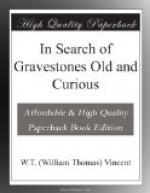The next problem is rather more doubtful, and in considering the possibility of the memorial indicated being “professional,” we must remember that the parish of West Ham, now a populous place, was quite out of town and almost undiscovered until a comparatively recent time. Its eighteenth-century gravestones are consequently for the most part rustic and primitive. The skull and other bones here depicted, decked with wheat-ears and other vegetation, probably have some literal reference to the agricultural pursuits of the deceased, although of course they may be only poetical allusions to the life to come.
Fig. 63.—At west Ham.
“To Andrew James, died 1754, aged 68 years.”
CHAPTER V.
A typical tramp in Kent.
This unpretentious work makes no claim to deal with the whole subject which it has presumed to open. Its aim is rather to promote in others the desire which actuates the author to follow up and develop the new field of antiquarian research which it has attempted to introduce. As old Weever says, in his quaint style:—“I have gained as much as I have looke for if I shall draw others into this argument whose inquisitive diligence and learning may finde out more and amende mine.”
This book, then, is not a treatise, but simply a first collection of churchyard curiosities, the greater number of which have been gathered within a comparatively small radius. It is only the hoard of one collector and the contents of one sketch-book, all gleaned in about a hundred parishes. Many collectors may multiply by thousands these results, bring out fresh features, and possibly points of high importance.
Two chief purposes therefore animate my desire to publish this work. One is to supply such little information as I have gleaned on a subject which has by some singular chance escaped especial recognition from all the multitude of authors, antiquarians, and literary men. I have searched the Museum libraries, and consulted book-collectors, well-read archaeologists, and others likely to know if there is any work descriptive of old gravestones in existence, and nothing with the remotest relation thereto can I discover.[1] There are, of course, hundreds of books of epitaphs, more or less apocryphal, but not one book, apocryphal or otherwise, regarding the allegories of the churchyard. Can it be that the subject is bereft of interest? If so, I have made my venture in vain. But I trust that it is not so.
[Footnote 1: The Rev. Charles Boutell published, in 1849, parts 1 and 2 of a periodical work entitled “Christian Monuments in England and Wales,” proposing to complete the same in five sections; the fifth to treat of headstones and other churchyard memorials, with some general observations on modern monuments. The two parts brought the subject down to the fifteenth century, and were so ably written and beautifully illustrated as to intensify our regret at the incompletion of the task.]




